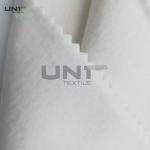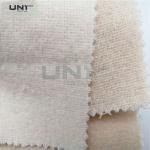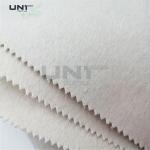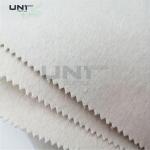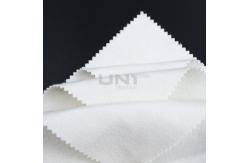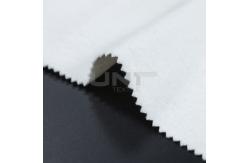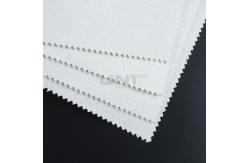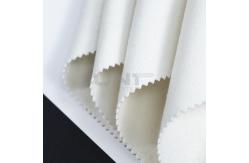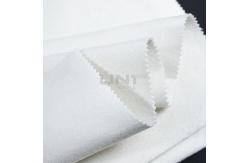Tie Interlining is a specialized type of interlining designed specifically for use
in neckties. It is used to give neckties their structure, shape,
and smooth appearance while providing a luxurious feel. Tie
interlining is essential for ensuring that the tie holds its form,
drapes naturally, and maintains its integrity throughout the day.
It is typically made from a variety of materials, including cotton,
polyester, and blends, to provide the necessary balance of weight,
flexibility, and durability. Key Characteristics of Tie Interlining- Lightweight yet Structured: Tie interlining is lightweight to ensure that the tie doesn’t
become bulky, yet it provides sufficient structure to allow the tie
to maintain its shape and achieve the desired knot.
- Smooth Finish: The interlining contributes to the smooth, sleek finish of a
necktie. It ensures the tie lies flat and resists creases, creating
a polished appearance.
- Flexible and Drape-Responsive: Tie interlining is designed to have flexibility so that it
conforms to the shape of the tie when tied. It allows for the
natural drape of the tie, ensuring it sits properly against the
chest.
- Durable and Resilient: High-quality tie interlining is durable and holds up over time,
allowing the tie to retain its form and resist wear, even with
frequent use.
- Variety of Materials: Tie interlining can be made from several different fabrics, such
as cotton, silk, and polyester blends. Some high-end ties may
feature wool-based or specialized interlinings to offer superior
support and texture.
Applications of Tie InterliningNeckties: The primary application for tie interlining is in the production
of neckties. The interlining provides the structure needed to make
the tie feel substantial, help it drape properly, and create a neat
knot. Bow Ties: Tie interlining is also used in the production of bow ties to
give them the necessary shape and firmness to hold their form
without becoming too rigid. Scarves and Pocket Squares: Some scarves and pocket squares use a form of tie interlining to
give them extra body, allowing them to retain their shape without
being overly stiff. Other Accessories: Tie interlining can also be used in the production of other
fashion accessories that require a certain level of structure, such
as belts or collar stays.
Benefits of Tie Interlining- Structure and Shape: Tie interlining is designed to give neckties and bow ties the
right amount of structure, so they maintain their shape even after
wearing for long periods.
- Smooth Finish: The interlining ensures a sleek, smooth look, helping the tie
stay flat and resist creases. It enhances the overall aesthetic of
the tie, contributing to a polished appearance.
- Durability: Tie interlining is made to last, offering durability and ensuring
that the tie does not lose its form after repeated use or cleaning.
- Comfort: The right interlining provides structure without sacrificing
comfort. It ensures that the tie feels soft and flexible against
the skin while retaining its shape.
- Versatility: Available in both fusible and non-fusible forms, tie interlining
can be adapted to different types of ties, fabrics, and finishes.
It can also be customized to meet the specific needs of a designer
or manufacturer.
Types of Tie Interlining- Fusible Tie Interlining: This type of interlining has an adhesive layer that allows it to
bond to the fabric when pressed with an iron. It is often used in
mass production as it provides a quicker and more permanent bond
between the fabric and the interlining.
- Non-Fusible Tie Interlining: Non-fusible interlining is sewn into the tie fabric, offering
flexibility for higher-end or custom-made ties where a more
delicate or handcrafted approach is required. This type of
interlining offers more freedom in terms of movement and comfort.
How to Apply Tie Interlining- Pre-wash: Pre-washing the fabric and interlining ensures that any potential
shrinkage or changes in texture are minimized.
- Cut to Size: Cut the tie interlining to the appropriate size for the tie. Make
sure the interlining fits within the tie’s edges, leaving room for
stitching or bonding.
- Fusible Interlining: If using fusible interlining, place it on the back side of the
fabric with the adhesive side facing the fabric. Use an iron to
fuse the two together, following the recommended temperature and
pressure settings.
- Sewing Non-Fusible Interlining: For non-fusible interlining, sew it into the tie fabric using a
basting stitch or a regular stitch. Make sure the interlining is
securely attached to prevent shifting during wear.
- Final Pressing: After applying the interlining, give the tie a final pressing to
ensure a smooth finish and to set the shape.
ConclusionTie Interlining plays a crucial role in the creation of neckties,
offering the perfect balance of structure, flexibility, and
comfort. It ensures that ties maintain their shape and drape
naturally, providing a smooth, sleek look that is essential for
formal and professional attire. Available in both fusible and
non-fusible options, tie interlining can be customized to suit
different types of fabrics and tie styles, making it an
indispensable component in high-quality necktie production. Whether
used for neckties, bow ties, or other accessories, tie interlining
is an essential element for achieving a refined, professional look |
